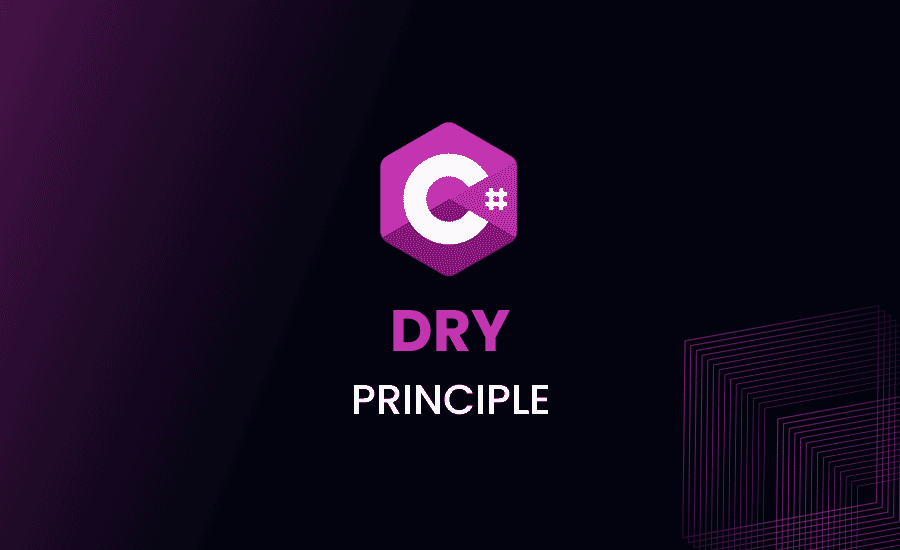DRY Principle in C# (Don’t Repeat Yourself) Explained

Do you enjoy coding but often find yourself typing the same piece of code repeatedly? Have you ever thought, ‘Hmm, there’s got to be a better way of doing this…?’ Well, guess what! There is, and it’s called the DRY Principle. So, fasten your seat belts, because you’re about to embark on an exciting journey through the world of DRY principle in C#.
Introduction
Imagine you’re about to embark on a journey where your life as a developer gets a whole lot easier. No more writing the same lines of code over and over again, no more hours spent debugging repeated code that presents the same error.
Sounds magical, doesn’t it? Get ready, for you are about to discover the magic world of the DRY principle in coding!
What is the DRY Principle?
DRY, an acronym that stands for “Don’t Repeat Yourself,” is more than just a simple mantra. It’s a coding principle that brings with it a systematic approach to help you code smarter, not harder. Still confused? Don’t worry, come with me; we’ve got some code to explore!
Loading code snippet...
In the NON-DRY code above, preparing tea and coffee involves the same steps- boiling water and optionally adding sugar. These steps are repeated in each function. It works, but there’s room for improvement.
Loading code snippet...
In the DRY version, the common steps are abstracted into a separate function BoilWaterAndAddSugar(). We’ve avoided repetition, and now, each function does exactly one thing. But how is this useful, you ask? It’s simple; whenever you need to change the logic for boiling water and adding sugar, you only have to alter the BoilWaterAndAddSugar() method. This makes the code more maintainable, easier to fix bugs, and helps you prevent future errors.
Imagine teaching a child to prepare lemonade. You wouldn’t teach them every step for each glass of lemonade they make. Instead, you’d teach them the procedure once and ask them to repeat the steps. If they want to make orange juice another time, they don’t need to learn the entire procedure from scratch again; instead, they apply the same steps, replacing lemons with oranges.
The DRY principle is the same idea. The child is applying the DRY principle by using the same procedure to prepare different types of juice.
The DRY principle is all about recognizing these opportunities to enhance your coding game. Read on, as we delve deeper and uncover more secrets of the DRY principle.
DRY Principle in C#
In this part of the guide, we dive deeper into the essence of the DRY Principle’s implementation in C#. We compare scenarios, dissect code examples, and provide tips on how to approach problem-solving with DRY in mind. Ready? Let’s get started!
Basic Concept behind DRY Principle in C#
In the context of C#, the DRY principle aims to avoid repetition by replacing duplicate logic or code snippets with shared methods or classes. It promotes creating reusable components so that future changes need to be implemented in only one place.
Consider an example where we’re implementing different functions for calculating the area of shapes like circles, squares, and rectangles.
Loading code snippet...
In the above code, there’s a clear redundancy in the method signatures, as the equivalent logical operation of calculating the area is divided amongst different methods. With DRY in mind, this could be improved as follows:
Loading code snippet...
We’ve created a single method ‘Area’ in an interface ‘IShape’. Now, all our shape classes (e.g., Circle, Rectangle, Square) implement this interface, thereby eliminating the need for separate methods for each shape.
Understanding the Core of DRY Principle in Coding
Picture this, you just finished a marathon coding session and the boss asks for one more feature before you call it a day. Your mind is exhausted but hey, you’re a fighter. Suddenly, your eyes fall on these mystery lines of code. You rack your brains, trying to decipher what in the world it’s doing. And then it strikes you, you’ve seen this before, somewhere else in the application. Familiar scenario? Welcome to the non-DRY world!
But worry not, the superhero of our story, the DRY principle, is here to the rescue! While the DRY principle promotes elimination of redundancy, its superpower lies in enhancing the readability, maintainability, and scalability of code.
Take it as cleaning your room. If everything’s in its place, finding that elusive comic book or gaming console becomes a breeze. Same goes with the code. Less clutter makes it easier to navigate and understand, and the fact that you’ve written less code means there’s less chance for bugs to creep in. I mean, who wouldn’t want that?
Now, imagine you are building a functionality that generates reports. Let’s say, two reports, each fetching data from different databases.
In the non-DRY version of the world, you’re sweating over your keyboard, coding the database fetching and data processing parts twice. Seeing double? Yeah, that’s double the code, doubly confusing and twice the probability of errors.
Loading code snippet...
Enter the DRY principle! The hero we need, but don’t deserve. With the DRY mindset, instead of duplicating the fetch and process parts for both reports, why not create a single method that does all the work?
It could be a shared method that takes database querying details as a parameter and carries out the processing. This way, you can simply call this function for each report. Voila, no more seeing double!
Loading code snippet...
Not only does this make the entire code shorter and more manageable, it’s also easier to change and maintain. It’s a win-win situation.
While “Less code, more problems” doesn’t sound quite right in a rap song, when it comes to coding, it’s spot-on!
Ever heard of the saying “Less is more”? Well, it couldn’t be truer than in DRY coding. Although it may sound contradicting, writing less code often yields more effective, efficient programs.
In other words, “Less code, more value”. Ready to turn up the heat and create some value with less code? Let’s DRY this! Phew, I didn’t mean to get you running for a towel! I meant, let’s learn “DRY-coding” 🙂
Practical Implementation of DRY Principle in C#
In this section, we will dive deep into how we can adopt the DRY principle in C# and steer clear of code repetition. Through practical examples, let’s see the remarkable transformation you might achieve by applying the DRY principle. You’d be amazed at what a difference it can make!
The Before and After of Using DRY Principle in C#
When we start writing a piece of software, it often begins quite straight-forward, but as we add more functionalities, complexities scale up and redundancy can creep in. Ever played with a set of Lego blocks? Just like how you can create a complex structure with simple, modular units, the DRY principle allows us to create intricate software with reusable pieces of code.
Let’s look at this with an example that even a kid can relate to, a simple arithmetic operation program! Initially, our codes for operations like addition, subtraction, multiplication, and division might look something like this:
Loading code snippet...
While it seems simple enough, there is a fair bit of redundancy here, right? As more operations get added, we would be repeating the same pattern of code, leading to unnecessary bloating of our program. So how can the DRY principle help here? Let’s beautify our code:
Loading code snippet...
By embracing the DRY principle, we now have a more compact equation calculator that can be easily maintained and expanded. Much like building a castle with Lego blocks, right? You could keep adding more operations to the Calculate method, and the structure stays lean and manageable.
But what about real-world scenarios, beyond basic math operations? Let’s consider a more complex case, a program that handles user authentication. Initially, our login and registration functions could look like this:
Loading code snippet...
There’s a glaring repetition here with the password hashing process. With DRY, we can extract the shared functionality and create a shared method PasswordHandler that both Register and Login can use, reducing the redundancy:
Loading code snippet...
We have now tidied up our authentication program significantly by removing redundancies and making it more maintainable. It might not look as colorful as your Lego castle, but this code sure is a work of art in the programming realm!
The DRY principle, as we’ve seen shapeshifts our codes into a beautiful form that is manageable, scalable, and a lot more enjoyable to write. So get ready to grab your set of coding ‘Lego blocks,’ and let’s start building some fantastic software together! Keep the mantra of ‘Don’t Repeat Yourself’ in mind, but also remember that balance is key. Now, let’s continue our journey to explore further the fascinating world of DRY programming.
Avoiding Code Repetition
We’ve all been there: scrolling through line after line of the same code, squinting at the screen, trying to make sense of what’s going on. It’s like trying to navigate through a maze where all the walls look the same. So, in the interest of keeping our sanity (and our eyesight), let’s dive deeper into some strategies that’ll help us steer clear of that dreaded beast: code repetition.
How the DRY Principle Helps Reduce Code Repetition
The DRY principle can give us a major leg-up when it comes to taming code repetition. With each change you make with code redundancy in mind, your codebase becomes leaner and easier to tackle. Each avoided instance of repetition means less chance of errors and more consistency. Sounds pretty neat, doesn’t it?
Imagine having a robot that does one task perfectly. Now, wouldn’t it be a waste to build the same robot again and again for the same task? Instead, we can create identical robots from the original design. Similarly, if you find repetitive code in your software, transform it into a single, reusable piece that can be called whenever needed.
Loading code snippet...
In the example above, we see the same string initialization and console log operation twice. So, we create a function greetUser(). Now, whenever we want to greet a new user, we can use this function – saving us extra work and reducing code clutter.
Techniques to Avoid Code Repetition in C#
As we embark on our mission to banish code repetition, it’s useful to keep a few handy strategies in our toolkit. Let’s explore them further.
- Use Functions and Methods: Functions and methods are your best friends when it comes to reducing redundant code. Once a function is defined, it can be used over and over again. Plus, if any tweaks are needed, there’s just one place you need to look.
Loading code snippet...
You see, we saved ourselves some work, right? No need to manually calculate each square!
- Leverage Inheritance and Polymorphism: Object-oriented principles aren’t just fancy jargon. Inheritance allows us to define a class and create sub-classes that inherit traits from the original, reducing code duplication.
In our software, we might have different types of accounts, like SavingsAccount and CurrentAccount. Here’s how we can use inheritance to make this more DRY.
Loading code snippet...
See what we’ve done? SavingsAccount and CurrentAccount both need to keep balance and getBalance method. So, we moved these to a super class – Account, making our code more DRY.
- Utilize Loop Structures: A bunny hops about the same way, whether it’s in a garden or a park, right? It just changes direction based on where it wants to go! Similarly, when it comes to repeated steps in code, we can utilize loops like for, while, do-while which help to reduce redundancy.
Loading code snippet...
There you have it! The same ‘Hi!’ written thrice, but without repeating the line.
By employing these techniques effectively, you can effectively avoid code repetition in your projects. With practice, you’ll not only save your time, but your code will also become more efficient, manageable and robust. So, are you ready to take the repetition bull by its horns and tame your codebase? Let’s do this!
Advantages of DRY Principle in C#
Get ready to explore some of the brilliant benefits of the DRY principle. And trust me, there’s more to it than just less typing!
Code Maintainability with DRY Principle
So, you’ve written code that works perfectly at the moment, but what about a few months down the line when there’s a bug or you decide to add more features? This is where maintainability comes into play. When it comes to maintainability, DRY code reigns supreme. But why though?
Imagine you’ve written a mind-blowing algorithm running throughout your codebase. But then, you spot a bug. If you had a piece of chocolate for every place you need to hunt down and amend that algorithm, you bet you’d be bouncing off the walls from all the sugar! But with DRY code, your algorithm is likely housed in a single function or class. Change it once, and it’s changed everywhere.
Loading code snippet...
By reducing repetition, DRY code paves the way for easier maintenance and adaptations in the future. It’s like building with Lego blocks – individual, interchangeable pieces that you can reposition without tearing down the entire structure!
Better Testing and Debugging Experience with DRY Principle
DRY code and debugging are like two peas in a pod. No, really! When it comes to testing and debugging your code, DRY programming practices can be a total lifesaver.
Imagine trying to play a game of hide-and-seek where there are a hundred different hiding places. That’s what it feels like trying to debug non-DRY code. When your code abides by the DRY principle, you can think of it like a game of hide-and-seek in a small room. There aren’t a hundred places to look for a problem. It’s easy to find what you’re looking for, and you can handle any bugs that try to play hide and seek with you!
Loading code snippet...
Testing also becomes easier and more efficient when dealing with DRY code. After all, fewer lines of code mean less surface area for bugs to creep into unnoticed.
Remember: striving for DRY code helps to produce more maintainable software that’s easier to debug. And we all know what that means: fewer headaches and more high fives!
Pitfalls and Misunderstandings of DRY Principle in C#
Hold your horses! Before we zealously start abstracting every single code duplication, hang tight as we delve into the deep trenches of common pitfalls and misconceptions associated with the DRY principle. We’re going to explore scenarios that’ll make us think twice about using DRY, and then we’ll lock horns with some of the most common misconceptions about this principle.
When Not to Use DRY Principle in C#
Seems strange to say, doesn’t it? After all, DRY is great! However, there are situations where applying the DRY principle might lead to greater complexity. So, let’s tour some of these scenarios and debunk the myth that DRY is a “one-size-fits-all” solution.
Let’s consider an instance of sorting an array. If we need to sort different arrays based on different conditions throughout our program, we can create a generic sorting function. However, sometimes creating this abstraction could lead to more complex code, potentially making it harder to understand.
Loading code snippet...
On a first glance, “SortArray” might seem like an improvement – a smart way to make the sorting DRY. But this could become problematic when you have more complicated code. You might need to pass multiple methods as parameters, making it convoluted and complex.
The key point to remember is, the DRY principle is not an excuse to overcomplicate your code. If making something reusable introduces more complexity, it could be better to leave the code as it is.
Common Misconceptions About DRY Principle and How to Avoid Them
Now, let’s confront some of the common misconceptions about the DRY principle. Misconstruing DRY can lead to tightly coupled and hard-to-read code. It’s time we tackle these misunderstandings head on.
One misconception is that the DRY principle is all about removing duplicate code. While it does advocate for code reuse, it’s more about the duplication of functionality, which is slightly subtler. If two code blocks do the same thing but aren’t structurally identical, those are prime spots for DRY.
Imagine this – you’re drawing a smiling sun. You draw a circle, two eyes, and a mouth. Now, you want to draw a second sun. Would you trace over the first sun, or draw a new one from scratch? The details might not be identical, but the process is the same. Just like our drawings, sometimes structurally different codes have the same intent – that’s where DRY comes into play!
Here’s an example:
Loading code snippet...
At first glance, they’re different. One’s for customers, the other for employees. Once we get past the surface, we notice the underlying functionality (data validation and saving) is the same.
Here’s the DRYed up version:
Loading code snippet...
Now, the validation logic is shared between the SaveCustomer and SaveEmployee methods.
In a nutshell, if you find yourself thinking, “Hey, I’ve done this before in another part of the code!”, that could be a potential candidate for applying DRY! Remember, the DRY principle is about recognizing and abstracting similar functionalities, not just the removal of clone code.
Tips and Tricks for Adopting the DRY Principle in C#
Mastering the DRY principle is definitely an impressive feat but to fully leverage its merits, we need more than just the theory. Let’s get into the nitty-gritty of code crafting and discover some secret techniques and tricks to truly elevate your C# programming skills to the next level. Not to worry, you’ll not get lost in the jungle of codes, as we have examples and explanations that are as simple as eating your favorite cheeseburger.
Best Practices to Keep Your Code DRY
Keeping your code DRY isn’t just about removing the redundant code, there are additional strategies that can help you achieve it and S.O.L.I.D principles and design patterns are an integral part of this pursuit.
S.O.L.I.D Principles
In the programming galaxy, SOLID principles serve as celestial beacons leading developers towards writing effective and efficient code. Each letter in SOLID stands for a specific principle as follows:
- S: Single Responsibility Principle
- O: Open/Closed Principle
- L: Liskov Substitution Principle
- I: Interface Segregation Principle
- D: Dependency Inversion Principle
Sounds tough, doesn’t it? Well, it’s not as complicated as it sounds. Think of it as cooking a dish. Each ingredient represents a principle, contributing to the final result – a savory codebase.
Here’s a code example that violates the SOLID principles:
Loading code snippet...
This interface violates both the Single Responsibility Principle and Interface Segregation Principle, as it requires developers to implement features that may not be necessary. For instance, an employee detail class may not need to print a report. Therefore, it’s better to break it down based on specific functionalities.
Loading code snippet...
In this modified example, all the responsibilities are neatly segregated and the single responsibility principle is also preserved.
Use of Design Patterns
Design patterns are like trusted blueprints refined over years by the developer community. They offer structured solutions to both common and unique programming challenges, allowing you to write DRY code easily.
Imagine you’re building a house. Now, this house can have several rooms – a drawing room, bedroom, kitchen, etc. Does it make sense to start from scratch for each room? Or to design one room well, and then use it as a reference for the others? The latter option, right? Well, that’s exactly what design patterns do. They allow you to build upon pre-existing solutions, ensuring your code is DRY and efficient.
Here’s a basic example of a Singleton pattern – a typically applicable design pattern in C#:
Loading code snippet...
Here, the Singleton pattern ensures that only one instance of a Singleton object exists, maintaining consistency across the application, and preventing redundancy.
Utilizing Tools and Frameworks That Support DRY Principle in C#
Going DRY in C# just got easier with various tools and frameworks that promote this concept implicitly.
Dependency Injection
Dependency Injection (DI) is like your favorite dynamic duo (think Batman and Robin!). It reduces hard-coded dependencies among your classes, making your code DRY, easy to test, and maintain.
Imagine you’re a detective (with an impressive cape, of course) and you need different sets of skill-based partners for different missions. Instead of training each new partner, wouldn’t it be easier if you could inject the required skills into your partner? That’s exactly what DI does!
Loading code snippet...
In this simple example, the _Service is a dependency of the Client class. Instead of instantiating it within the class, we have injected the concrete service object into the client class – a basic form of dependency injection.
Aspect-Oriented Programming (AOP)
AOP can be considered like a magic trick in our coding performance. It allows us to introduce additional behavior (also known as cross-cutting concerns) to existing code without modifying the code itself!
Won’t that be awesome if you could perform a magic trick that cleans your room without touching a thing? Well, AOP does exactly that with your code!Messy room here refers to your codebase, and objects lying around are different functionalities. AOP tidies up these functionalities without moving the objects themselves.
Loading code snippet...
In this example, OnEntry serves as an aspect that introduces logging functionality wherever it’s referenced, without modifying the existing code.
By developing a thorough understanding of these principles, patterns, techniques, and tools, adopting the DRY principle in C# can be a cakewalk. Just remember, learning to code is like learning a new language. It may seem challenging at first, but with practice and dedication, sky’s the limit!
Conclusion
Phew, that was a roller coaster ride, right? By mastering the DRY principle in C#, we’re taking giant steps towards better coding practices. Cleaner, efficient, maintainable- all without losing our sanity!
Just remember, while DRY can transform your approach to coding, it’s not an end-all-be-all solution. The goal is writing efficient code, and sometimes that might mean going against DRY. Keep practicing, keep learning, and soon, you’ll find the perfect balance that works best for your programming style.
Ready to get rocking with the DRY principle in C#? What are you waiting for? It’s time to code!





